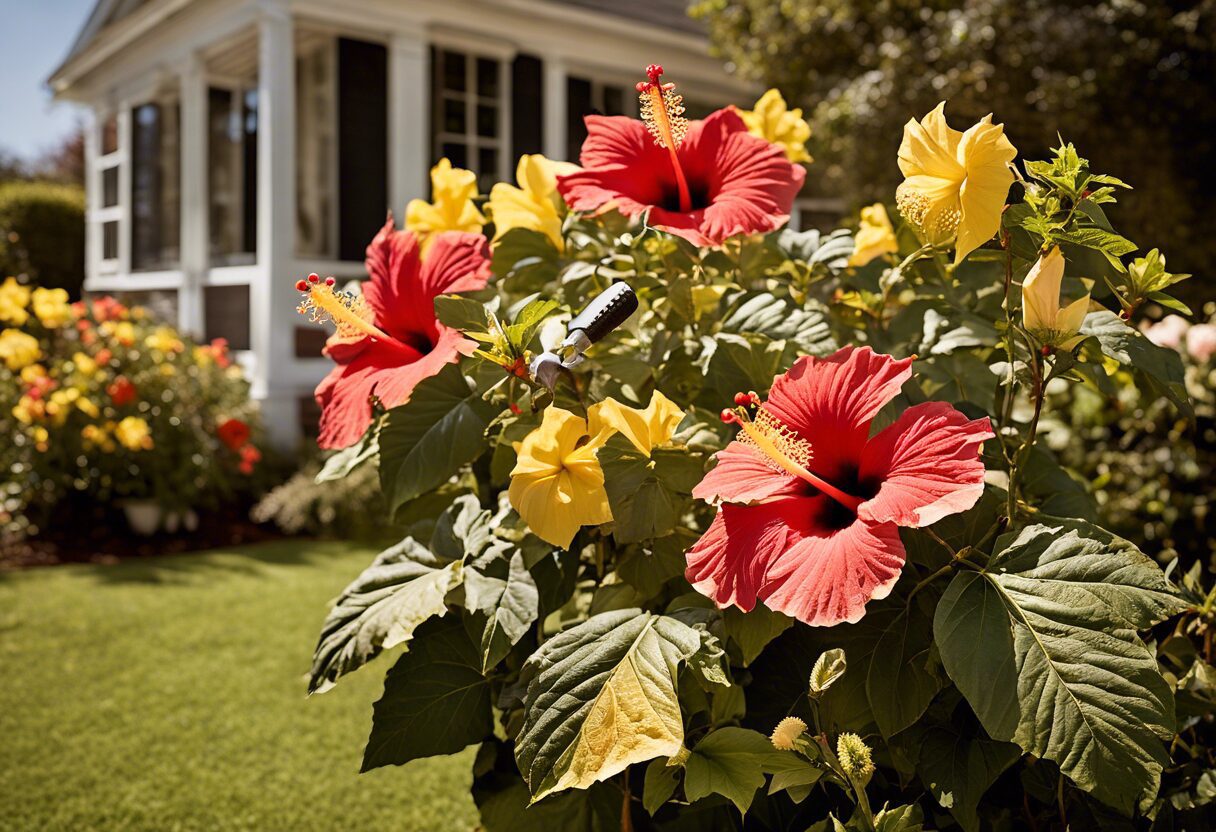Ever found yourself staring at a wilting Hibiscus, wondering where you went wrong? Well, my friend, you’re not alone. Many of us have been in that same spot, scratching our heads and asking Google How to Revive a Dying Hibiscus.
Don’t fret! We’ve got your back. This guide is here to help you understand what might be causing your hibiscus plant’s distress and how to bring it back from the brink of death. So buckle up and get ready for some serious plant-saving action! Keep reading about How to Revive a Dying Hibiscus?
Key Takeaways
- Identify signs of a dying hibiscus, such as yellow leaves, wilting, and lack of blooms.
- Overwatering or underwatering can cause issues; ensure the soil is moist but not waterlogged.
- Provide adequate sunlight; hibiscus needs six hours of direct sunlight daily.
- Check for pests or diseases and treat accordingly with insecticides or fungicides.
- Fertilize regularly with a high-potassium fertilizer to promote blooming.
- Prune dead branches to stimulate new growth.
Understanding the Hibiscus Plant
The hibiscus plant is a tropical beauty, known for its vibrant flowers and lush foliage. It’s not just a pretty face though – understanding hibiscus plant care and hibiscus growth conditions can help you keep your plant thriving. Common hibiscus problems often stem from neglect or improper care, but don’t worry! We’re here to guide you on how to revive a dying hibiscus.
Recognizing a Dying Hibiscus
So, how do you know if your hibiscus is in trouble? Well, there are some telltale signs of dying hibiscus that you can look out for. Changes in leaf color are usually the first red flag. If your hibiscus leaves start turning yellow or brown, it’s time to take action.
Another sign of an unhealthy hibiscus is a decrease in flower production. If your once vibrant and blooming hibicuses are now looking sparse and lackluster, it might be time to intervene.
Overall health is also crucial when recognizing an unhealthy hibiscus. If the plant looks wilted or droopy despite proper watering, it’s likely struggling.
The Life Cycle of a Hibiscus
Understanding the life cycle of a hibiscus can also be helpful in maintaining its health. The journey from seedling to mature plant involves several stages – each with its own set of needs and challenges.
In the early stages of the hibiscus life cycle, the seedlings need plenty of light and water to grow strong roots and stems. As they mature into flowering plants, their needs change slightly – they’ll require more nutrients but less water.
Eventually, all good things must come to an end – even for our beloved hibicus plants. The decline phase marks the end of the lifespan of a hibiscus plant. But don’t fret! With proper care and attention, you can prolong this stage and keep your hibiscus blooming for many years to come.
Causes of a Dying Hibiscus

Hey there, green thumbs! Ever wondered why your hibiscus seems to be on the fritz? Well, common hibiscus plant problems can often be traced back to three main culprits: inadequate watering, poor soil quality, and those pesky pests or diseases. Let’s dive into these dying hibiscus causes, shall we?
Inadequate Watering
Now, you might think watering is a no-brainer. But hold up! It’s not just about drenching your plant in H2O. Overwatering can cause root rot, while underwatering leaves your hibiscus parched and wilting.
So what’s the solution? Balance is key here. Your hibiscus needs enough water to thrive but not so much that it ends up swimming. Remember, folks – too much love can kill ya!
Poor Soil Quality
Next up on our list of hibiscus care mistakes is poor soil quality. Your hibiscus isn’t a fan of junk food – it needs nutrient-rich soil to grow strong and healthy.
But wait, there’s more! The pH level of the soil matters too. Hibiscuses prefer slightly acidic conditions. So if your soil is more ‘alkaline’ than an 80s pop song, you’ve got yourself a problem.
Pests and Diseases
Last but definitely not least are pests and diseases – the bane of every gardener’s existence! These little critters and creepy crawlies can wreak havoc on your precious hibiscus.
Common offenders include aphids, whiteflies, and spider mites (yuck!). And let’s not forget fungal diseases like rust and leaf spot. Keep an eye out for these nasties if you want to know how to revive a dying hibiscus.
How to Revive a Dying Hibiscus?
When your hibiscus is on the brink, don’t panic! Reviving dying hibiscus isn’t rocket science. It’s all about understanding the basics of hibiscus plant care and applying some simple hibiscus revival techniques. So let’s dive in!
Adjusting Watering Techniques
First off, let’s talk water. Too much or too little can send your hibiscus into a tailspin. Overwatering can cause root rot, while underwatering leaves your plant parched and wilting.
The key to reviving hibiscus with water is balance. Your hibiscus doesn’t want to swim, nor does it want to go thirsty. Aim for moist but well-drained soil.
Remember, every plant has its own “drink” preference. So keep an eye on yours and adjust as needed.
Improving Soil Quality
Next up, soil quality! If you’re trying to bring back a fading flower, improving the earth it calls home is crucial. Poor soil equals poor health; it’s as simple as that.
Start by checking the pH level of your soil. Hibiscuses prefer slightly acidic conditions (pH 6-7). If yours is off-kilter, consider adding some organic matter or compost to balance things out.
And remember folks: good drainage is key! Soggy roots are a no-go for these tropical beauties.
Treating Pests and Diseases
Last but not least: pests and diseases – every gardener’s nightmare! These pesky problems can quickly turn a healthy hibiscus into a wilting wallflower.
Common culprits include aphids, whiteflies, and spider mites (oh my!). And let’s not forget fungal diseases like rust or leaf spot.
But fear not! With the right pest control for hibiscuses and disease treatment, your plant can bounce back in no time. Just remember to act fast – the sooner you tackle these issues, the better your chances of reviving a dying hibiscus.
Preventive Measures for Healthy Hibiscus Growth
Preventive measures are your best bet in maintaining the health of your hibiscus. It’s like giving your plant a regular check-up! You know, just to make sure everything’s hunky-dory. We’re talking about regular pruning, proper fertilization, and finding the ideal location and climate for your green buddy.
Regular Pruning
So, you’ve heard of haircuts, right? Well, plants need them too! Regular pruning is like a spa day for your hibiscus. It helps promote new growth and keeps the plant healthy. Think of it as giving your hibiscus a fresh start every now and then. Remember, pruning isn’t just about snipping here and there; it’s an art that requires understanding the needs of the plant.
Proper Fertilization
Next up on our list of hibiscus care tips is proper fertilization. Now, this doesn’t mean dumping a bag of fertilizer on your plant and calling it a day! Nope, it’s about providing balanced nutrition to support vibrant blooms and robust growth. Think of it as cooking for your plant—you wouldn’t want to over-season or under-season, would you?
Ideal Location and Climate
Lastly, let’s talk real estate—plant real estate that is! The location and climate play crucial roles in healthy hibiscus growth. These plants love warm climates with plenty of sunlight but not too much heat—kinda like Goldilocks’ porridge preferences! So find that sweet spot where your hibiscus can soak up some rays without getting sunburnt. And remember folks, when figuring out how to revive a dying hibiscus, sometimes all it takes is a change in scenery!
To Wrap Up
In the wild, hibiscus plants are like the Bear Grylls of the plant world, but in our gardens, they can be more like a pampered poodle. So, if your hibiscus is throwing a diva tantrum and looking a bit under the weather, don’t panic! Remember, with the right care and attention as we’ve discussed in How to Revive a Dying Hibiscus, you can turn that wilting wallflower back into a blooming superstar.
So let’s get those green thumbs working and give your hibiscus the TLC it deserves. After all, every plant has its day in the sun!


